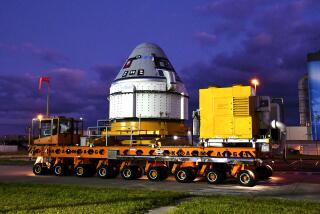NASA Search Continues for Shuttle Leak
- Share via
KENNEDY SPACE CENTER, Fla. — NASA workers found a tiny leak in Columbia’s rear engine compartment Thursday but judged it too small to have caused the hydrogen leak that delayed the shuttle launch.
“The feeling is at this point that’s probably not what they’re looking for,” said Bruce Buckingham, a spokesman for the National Aeronautics and Space Administration.
The search was to continue through the day, being halted long enough for Columbia’s on-board fuel tanks to be drained. Officials planned to increase pressure on the shuttle’s external tank, which is filled with helium, in an attempt to find the main leak, Buckingham said.
The external tank was being filled with more than a half-million gallons of super-cold liquid hydrogen and liquid oxygen Tuesday when the leak was detected. NASA promptly called off the launch and drained the explosive propellant.
Engineers believe the leak is in or near a 17-inch valve in a pipe that carries fuel from the external tank to the main engines.
If the leak is detected and repairs can be made at the launch pad, Columbia might be ready to lift off by the middle of next week. But, if Columbia has to be returned to a hangar, the delay would be about a month, NASA officials said.
Columbia’s astronomy mission, with a $150-million observatory called Astro, already had been delayed two weeks because of repairs to the shuttle’s cooling system. The latest postponement will mean even more changes to Astro’s observing schedule.
One of the prime targets, Comet Austin, is speeding away from Earth, making observations more difficult with every passing day. Halley’s Comet was to have been studied had the mission proceeded as scheduled in March, 1986, but the Challenger explosion pushed the launch date back.
More to Read
Sign up for Essential California
The most important California stories and recommendations in your inbox every morning.
You may occasionally receive promotional content from the Los Angeles Times.













